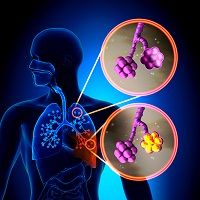Article
COPD and Asthma Symptoms Overlap in Older Patients
Author(s):
Patients can develop symptoms of both COPD and asthma, and the percentage increases as patients age.

Up to half of older adults may suffer from symptoms of both asthma and chronic obstructive pulmonary disease (COPD), according to findings presented at the American College of Allergy, Asthma and Immunology Annual Scientific Meeting in Atlanta in November.
Researchers also said the percentage of patients who experience symptoms of both diseases increases as the population ages.
“Based on symptoms alone, it can be difficult to diagnose COPD versus asthma,” said allergist William Busse, MD, ACAAI fellow and presenter in a press release. “The pathway to a diagnosis of COPD or asthma — smoking versus a long-term persistence of asthma – can be quite different. In every patient, but in older patients in particular, we need to take a thorough history and perform a physical examination, as well as measurements of lung functions. In patients with COPD and asthma, the changes in lung function may be severe, and it is not often readily apparent, which is the predominant, underlying condition – asthma or COPD. Treatment will differ depending on diagnosis.”
Treatments for these symptoms mainly are aimed at reducing inflammation via corticosteroids, and inhaled corticosteroids. However, changes in lung function due to COPD are caused by cigarette smoking, noted the researchers, and except exacerbations, those changes are not particularly responsive to corticosteroids.
“The primary treatment in COPD is bronchodilators, including long-acting beta agonists,” allergist Michael Foggs, MD, ACAAI president, continued in the statement. “They help relax muscles around the airways in the lungs, allowing air to flow more freely. They should not be given alone to people with asthma. In COPD, but not asthma, inhaled corticosteroids have been associated with an increased risk for pneumonia and in some cases, features of both asthma and COPD exist. For these patients a combination of inhaled corticosteroids and long-acting beta agonists is usually best.”
Bronchodilators are used for treatments of both COPD and asthma, and other treatments are generally more specific to unique conditions. Asthma patients are encouraged to avoid their personal triggers, like avoiding pets in the home or the outdoors when allergen concentrations are high. Similarly, COPD patients are told to avoid one main trigger: smoking. Cigarettes can worsen the diseases and reduce the effectiveness of inhaled corticosteroids.
The researchers suggest allergists should recognize each patient and their symptoms are a unique set of circumstances and should be treated on an individual basis. Patients need to be straightforward and tell physicians all of their symptoms and complete medical history before a correct diagnosis and medication regimen can be appropriately determined.



